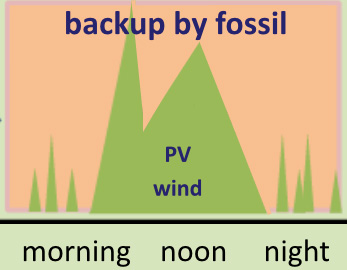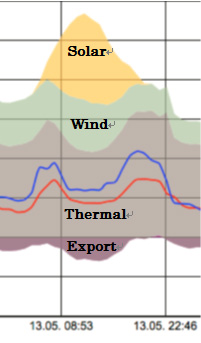Better Information for decision makers in Japanese
Electric Power Companies in Japan control the grid and the information about how the electricity system works. By controlling the information they can manipulate decision makers, against the interest of Japan and the customers – in favor only of themselves.
Separating the ownership and control of the electricity grid from the ownership of power plants makes it possible to have competition between producers, and open the market for modern low cost renewable domestic sources of energy.
Important is also that an independent operator of the electricity grid can provide public access to information on how the electricity system really works. Thereby it will no longer be possible for electric power companies to mislead the public and politicians will false arguments.
Politicians in Japan were recently provided such misleading information regarding the role of renewable electricity as part of an electricity system. The daily production was depicted in a set of graphs together with the conclusion that PV and wind was less good than nuclear power.

Source:Ministry of Economy, Trade and Industry, 28 April 2015
http://www.enecho.meti.go.jp/committee/council/
basic_policy_subcommittee/mitoshi/008/pdf/008_08.pdf P.9
But was the image provided correct and relevant? The politicians could not check. There is no independent operator of the Japanese electricity system who provides data on how the supply varies from different sources of electricity.
But there is open access to such data in Europe. Germany has a lot of wind and solar electricity. It is approximately the same size as Japan. Real-time data for the whole country is available online at https://www.energy-charts.de/price.htm.
This real data for the 13th of May shows that demand varies faster than solar or wind based generation. Solar production in Germany has the advantage that it produces electricity in the middle of the day when demand is maximum and electricity production cost traditionally highest. Solar electricity thus has proven to be more valuable than electricity from in-flexible coal and nuclear power plants.
On this day wind power produced approximately 10 GW with very small variations.
Despite Japan having less solar and wind power plants than Germany, real data for Japanese electricity production would certainly look more like real German data than like the drawing from METI and the power industry.
For countries in northern Europe data is available on-line at http://elstatistik.se/. On the same day, Sweden, the most nuclear intensive country in the world, looked like the bar on the right hand side.
Again we see that wind power provides electricity with almost constant output during 24 hours. There are no spikes of the kind seen in the illustrations made for Japanese politicians.
Flexible generators like hydropower plants or plants fired with bioenergy or fossil fuels are desired to firstly meet variation in demand. But the worst problem for the grid operator is always the unpredicted loss of power when a nuclear reactor or large coal fired unit suddenly stops because of some technical failure. Variations in renewable solar and wind are more predictable and easy to manage.
This example illustrate how important it is to remove the monopoly control of the grid from the electricity producing companies who have an interest in keeping electricity prices high, hinder competition, and keep Japan dependent on imported nuclear and fossil fuels.
One may also wonder if the Japanese politicians would have had a different vision for the future energy mix if they had access to correct information, instead of the misleading images provided.



